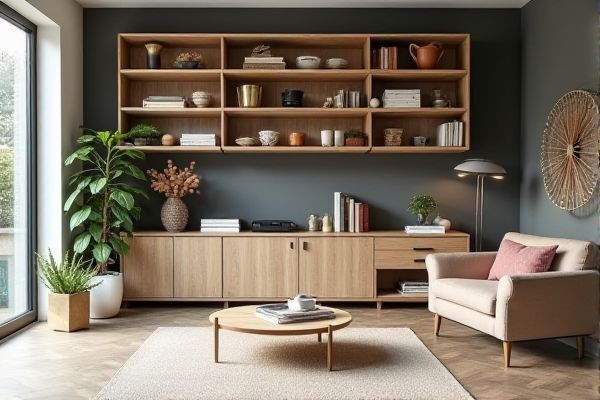
Open shelving offers easy access and a visually airy design, perfect for displaying your favorite items and creating a sense of space, while closed shelving provides a cleaner, more organized look that hides clutter and protects belongings from dust. Explore the rest of the article to discover which shelving style best suits your needs and enhances your home decor.
Table of Comparison
| Feature | Open Shelving | Closed Shelving |
|---|---|---|
| Visibility | Items fully visible, easy access | Items hidden, less visual clutter |
| Maintenance | Requires frequent dusting | Less dust exposure, easier upkeep |
| Style | Modern, airy, decorative | Traditional, sleek, concealed |
| Storage Protection | Less protection, exposure to dust | Protects items from dust and damage |
| Cost | Generally more affordable | Typically more expensive due to doors |
| Use Case | Display decor, frequently used items | Store valuables, clutter-prone items |
Open Shelving vs Closed Shelving: An Overview
Open shelving offers easy access and visibility, making it ideal for displaying decorative items and frequently used essentials, while also creating a sense of spaciousness in smaller rooms. Closed shelving provides concealed storage that protects items from dust and maintains a tidier appearance, benefiting environments requiring organization and clutter control. Both styles serve functional and aesthetic purposes, with the choice depending on user needs for accessibility, design preference, and storage requirements.
Aesthetic Appeal: Style Differences
Open shelving offers a modern, airy aesthetic that showcases decorative items, plants, and kitchenware as part of the room's design, creating a sense of openness and accessibility. Closed shelving provides a more streamlined, minimalist look by concealing clutter and emphasizing sleek cabinet fronts, contributing to a clean and polished appearance. The choice between open and closed shelving significantly influences the overall style, where open shelves highlight personalization and visual interest, while closed shelves prioritize uniformity and order.
Storage Capacity and Organization
Open shelving offers easy access and visibility, making items quickly identifiable but often limits storage capacity due to lack of contained space. Closed shelving provides greater storage capacity by utilizing enclosed compartments that protect items from dust and clutter, enhancing overall organization. Choosing between them depends on the need for accessible display versus maximizing stored item volume and neatness.
Accessibility and Convenience
Open shelving offers immediate visibility and easy access to frequently used items, enhancing daily convenience and efficiency in kitchen or storage spaces. Closed shelving protects contents from dust and clutter, maintaining a clean appearance but requiring doors to be opened, which can slow access. Choosing between open and closed shelving depends on balancing quick accessibility with the need for organization and protection.
Maintenance and Cleaning Requirements
Open shelving requires frequent dusting and cleaning due to constant exposure to air and particles, making it more high-maintenance compared to closed shelving. Closed shelving protects items from dust and dirt, reducing cleaning frequency and preserving item condition better over time. Both options demand regular upkeep, but closed shelving offers a more convenient solution for minimizing maintenance efforts.
Impact on Room Size and Lighting
Open shelving enhances the perception of room size by creating a more spacious and airy feel, allowing natural light to flow freely and brighten the area. Closed shelving, while offering more storage privacy, tends to visually shrink a room and can obstruct light, making spaces appear smaller and more enclosed. Your choice between open and closed shelving directly influences the ambiance, lighting distribution, and spatial openness of your living space.
Cost Comparison: Budget Considerations
Open shelving typically costs less than closed shelving due to fewer materials and simpler installation, making it a budget-friendly option for your storage needs. Closed shelving often involves doors, hardware, and additional construction, increasing overall expenses. When managing costs, consider that open shelving provides affordability and easy customization without sacrificing functionality.
Best Uses for Open Shelving
Open shelving is ideal for displaying frequently used items like dishes, cookbooks, and decorative pieces, making them easily accessible and visually appealing. It enhances kitchen organization by encouraging neatness and offering quick visibility to stored items, especially in smaller spaces. Open shelves work best in kitchens with a cohesive design aesthetic and where maintenance of cleanliness and order is manageable.
Ideal Scenarios for Closed Shelving
Closed shelving is ideal for environments requiring dust protection and organized storage, such as offices, kitchens, or libraries with valuable books. It offers enhanced security for fragile or sensitive items by preventing accidental damage and restricting access. Enclosed shelves also support a cleaner aesthetic by concealing clutter and maintaining visual harmony in living or workspaces.
Making the Right Choice for Your Space
Open shelving enhances room openness and accessibility, ideal for displaying decorative items and frequently used objects, but requires regular organization to maintain a tidy look. Closed shelving offers concealed storage, protecting belongings from dust and creating a streamlined appearance, making it suitable for clutter-prone areas or minimalist designs. Assessing factors like room size, usage patterns, and aesthetic preferences helps determine the best shelving option for functional and visual harmony in your space.
 homyna.com
homyna.com